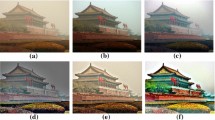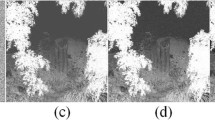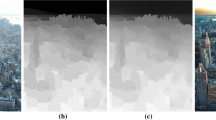Abstract
The single image dehazing is performed using atmospheric scattering model (ASM). The ASM is based on transmission and atmospheric light. Thus, accurate estimation of transmission is essential for quality single image dehazing. Single image dehazing is of prime focus in research nowadays. The proposed work presents a fast and accurate method for single image dehazing. The proposed method works in two folds; (i) An adaptive dehazing control factor is proposed to estimate accurate transmission, which is based on difference of maximum and minimum color channel of hazy image, and (ii) a mathematical model to compute probability of a pixel to be at short distance is presented, which is utilized to locate haziest region of the image to compute the value of atmospheric light. The proposed method obtains visually compelling results, and recovers the information content (such as structural similarity, color, and visibility) accurately. The computation speed and accuracy of the proposed method is proved using quantitative and qualitative comparison of results with state of the art dehazing methods.




















Similar content being viewed by others
References
Berman D, Treibitz T, Avidan S (2016) Non-local image dehazing. In: IEEE conference on computer vision and pattern recognition, pp 1674–1682
Cai B, Xu X, Jia K, Qing C, Tao D (2016) Dehazenet: an end-to-end system for single image haze removal. IEEE Trans Image Process 25(11):5187–5198
He K, Sun J, Tang X (2011) Single image haze removal using dark channel prior. IEEE Trans Pattern Anal Mach Intell 33(12):2341–2353
He K, Sun J, Tang X (2012) Guided image filtering. IEEE Trans Pattern Anal Mach Intell 35(6):1397–1409
Jha DK, Gupta B, Lamba SS (2016) l2-norm-based prior for haze-removal from single image. IET Comput Vis 10(5):331–341
Jing P, Su Y, Nie L, Gu H, Liu J, Wang M (2019) A framework of joint low-rank and sparse regression for image memorability prediction. IEEE Trans Circuits Syst Video Technol 29(5):1296–1309
Kim J-H, Jang W-D, Sim J-Y, Kim C-S (2013) Optimized contrast enhancement for real-time image and video dehazing. J Vis Commun Image Represent 24(3):410–425
Kim J-Y, Kim L-S, Hwang S-H (2001) An advanced contrast enhancement using partially overlapped sub-block histogram equalization. IEEE Trans Circuits Syst Video Technol 11(4):475–484
Kim TK, Paik JK, Kang BS (1998) Contrast enhancement system using spatially adaptive histogram equalization with temporal fltering. IEEE Trans Consum Electron 44(1):82–87
Li B, Peng X, Wang Z, Xu J, Feng D (2017) Aod-net: all-in-one dehazing network. In: IEEE international conference on computer vision, pp 4780–4788
Li Y, Miao Q, Song J, Quan Y, Li W (2016) Single image haze removal based on haze physical characteristics and adaptive sky region detection. Neurocomputing 182:221–234
Ling Z, Fan G, Gong J, Wang Y, Lu X (2017) Perception oriented transmission estimation for high quality image dehazing. Neurocomputing 224:82–95
Liu S, Rahman A Md, Liu SC, Wong CY, Lin C-F, Wu H, Kwok N (2016) Image de-hazing from the perspective of noise filtering. Comput Electr Eng 62:345–359
Lu H, Li Y, Xu X, He L, Li Y, Dansereau D, Serikawa S (2016) Underwater image descattering and quality assessment. In: IEEE international conference on image processing, pp 1998–2002
Lu H, Li Y, Zhang L, Serikawa S (2015) Contrast enhancement for images in turbid water. J Opt Soc Am A 32(5):886–893
Ma K, Liu W, Wang Z (2015) Perceptual evaluation of single image dehazing algorithms. In: IEEE international conference on image processing
Mantiuk R, Kim KJ, Rempel AG, Heidrich W (2011) Hdr-vdp-2: a calibrated visual metric for visibility and quality predictions in all luminance conditions. ACM Trans Graph 30(4):40:1–40:14
Mantiuk R, Kim KJ, Rempel AG, Heidrich W (2011) Hdr-vdp-2: a calibrated visual metric for visibility and quality predictions in all luminance conditions. In: ACM SIGGRAPH 2011 Papers, SIGGRAPH ’11. ACM, New York, pp 40:1–40:14
Meng G, Wang Y, Duan J, Xiang S, Pan C (2013) Efficient image dehazing with boundary constraint and contextual regularization. In: IEEE international conference on computer vision, pp 617–624
Middleton WEK (1954) Vision through the atmosphere. Phys Today, 7, 21–21
Narasimhan SG Models and algorithms for vision through the atmosphere. PhD thesis, New York, NY, USA, 2004. AAI3115363
Narasimhan SG, Nayar SK (2000) Chromatic framework for vision in bad weather. In: IEEE conference on computer vision and pattern recognition, vol 1, pp 598–605
Narasimhan SG, Nayar SK (2003) Contrast restoration of weather degraded images. IEEE Trans Pattern Anal Mach Intell 25(6):713–724
Nayar SK, Narasimhan SG (1999) Vision in bad weather. In: IEEE conference on computer vision, vol 2, pp 820–827
Nayar SK, Narasimhan SG (2003) Interactive deweathering of an image using physical models. In: IEEE workshop on color and photometric methods in computer vision in cnjunction with IEEE conference on computer vision
Raikwar SC, Tapaswi S (2018) An improved linear depth model for single image fog removal. Multimed Tools Appl 77(15):19719–19744
Raikwar SC, Tapaswi S (2018) Tight lower bound on transmission for single image dehazing. The Visual Computer
Ren W, Si L, Zhang H, Pan J, Cao X, Yang M-H (2016) Single image dehazing via multi-scale convolutional neural networks. In: European conference on computer vision
Schechner YY, Narasimhan SG, Nayar SK (2001) Instant dehazing of images using polarization. In: IEEE Conference on computer vision and pattern recognition, vol 1, pp 325–332
Serikawa S, Lu H (2014) Underwater image dehazing using joint trilateral filter. Comput Electr Eng 40(1):41–50
Shwartz S, Namer E, Schechner YY (2006) Blind haze separation. In: IEEE conference on computer vision and pattern recognition, vol 2, pp 1984–1991
Silberman N, Hoiem D, Kohli P, Fergus R (2012) Indoor segmentation and support inference from rgbd images. In: European conference on computer vision. Berlin, Heidelberg, pp 746–760
Stark JA (2000) Adaptive image contrast enhancement using generalizations of histogram equalization. IEEE Trans on Image Processing 9(5):889–896
Tan K, Oakley JP (2000) Enhancement of color images in poor visibility conditions. In: IEEE conference on image processing, vol 2, pp 788–791
Tan R (2008) Visibility in bad weather from a single image. In: Proceedings of IEEE conference on computer vision and pattern recognition, pp 24–26
Tang K, Yang J, Wang J (2014) Investigating haze-relevant features in a learning framework for image dehazing. In: IEEE international conference on computer vision and pattern recognition, pp 2995–3002
Tarel J-P, Hautière N, Cord A, Gruyer D, Halmaoui H (2010) Improved visibility of road scene images under heterogeneous fog. In: IEEE intelligent vehicle symposium, pp 478-485, San Diego, California, USA. http://perso.lcpc.frtarel.jean-philippe/publis/iv10.html
Tarel JP, Hautière N (2009) Fast visibility restoration from a single color or gray level image. In: IEEE international conference on computer vision, pp 2201–2208
Wang W, Yuan X, Wu X, Liu Y (2017) Dehazing for images with large sky region. Neurocomputing 238:365–376
Wang W, Yuan X, Wu X, Liu Y (2017) Fast image dehazing method based on linear transformation. IEEE Trans Multimedia 19(6):1142–1155
Wang Z (2003) The ssim index for image quality assessment
Wang Z, Bovik AC, Sheikh HR, Simoncelli EP (2004) Image qualifty assessment: from error visibility to structural similarity. IEEE Trans Image Process 13 (4):600–612
Xiao C, Gan J (2012) Fast image dehazing using guided joint bilateral filter. Vis Comput 28(6):713–721
Yuan H, Liu C, Guo Z, Sun Z (2017) A region-wised medium transmission based image dehazing method. IEEE Access 5:1735–1742
Zhang Y-Q, Ding Y, Xiao J-S, Liu J, Guo Z (2012) Visibility enhancement using an image filtering approach. EURASIP Journal on Advances in Signal Processing 2012(1):220–225
Zhu Q, Mai J, Shao L (2015) A fast single image haze removal algorithm using color attenuation prior. IEEE Trans Image Process 24(11):3522–3533
Author information
Authors and Affiliations
Corresponding author
Ethics declarations
Conflict of interests
Authors Suresh Chandra Raikwar and Shashikala Tapaswi declare that they do not have any conflict of interest.
Additional information
Publisher’s note
Springer Nature remains neutral with regard to jurisdictional claims in published maps and institutional affiliations.
Rights and permissions
About this article
Cite this article
Raikwar, S.C., Tapaswi, S. Adaptive dehazing control factor based fast single image dehazing. Multimed Tools Appl 79, 891–918 (2020). https://doi.org/10.1007/s11042-019-08120-z
Received:
Revised:
Accepted:
Published:
Issue Date:
DOI: https://doi.org/10.1007/s11042-019-08120-z




